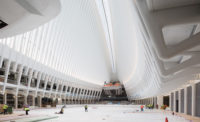Is it the best of times, or the worst of times, for Santiago Calatrava? One of the few architects whose name is recognized around the world, he lives like a pasha (with no fewer than three town houses on Park Avenue in Manhattan, and lavish homes in Spain and Switzerland), while shuttling to building sites in Europe, Asia, and both North and South America. His bridges draw tourists to cities as diverse as Venice, Jerusalem, Calgary, and Dallas. And he is about to be the subject of a show at the State Hermitage Museum in St. Petersburg (Santiago Calatrava: The Quest for Movement, June 27 to September 30, 2012).
Related links
- Calatrava Pulls Out of Denver Airport Project
- Dallas Celebrates Its New Calatrava Bridge
- Bumpy Ride for WTC Transit Hub
- Calatrava’s Bridge in Jerusalem Incites Controversy
- Calatrava’s Museum of Tomorrow in Rio
But he has also been the target of intense criticism, much of it involving the staggering costs of his buildings. In New York, the price of his transit hub at Ground Zero has risen to $3.8 billion. In Valencia, his hometown, he has been described as “bleeding the government dry,” with architectural fees approaching 100 million euros for his City of Arts and Sciences. And there have been questions about the practicality of some of his designs. Calatrava was happy to tackle these subjects by phone from Zurich.
Architectural Record: Will the show at the Hermitage be like the one at the Metropolitan Museum of Art in 2005?
Santiago Calatrava: It’s much bigger. The Metropolitan wanted to make a very dense show. This one will be about 20,000 square feet. There will be 60 or 70 architectural models, and also sculptures and watercolors that will let people understand my approach to projects.
Some critics of your show at the Metropolitan thought you were trying to present yourself as an artist like Brancusi, whose work was shown near yours, rather than as an architect.
I never saw it like that. It has never been my intention to, let’s say, do a sculpture to imitate the great art of Brancusi, just as Brancusi never wanted to imitate Rodin. I do those pieces as a vehicle to research architecture, like le Corbusier—la recherche patiente, the patient research. It’s a very intimate work.
Have you ever sold your art?
I have been tempted, very much in the beginning, to work with an art dealer, but then I renounced that because my production is so limited.
It’s been reported that your house in Valencia may someday become a Calatrava museum.
I don’t have the ambition to do a museum, although we have been taking care to archive all these things. Tina [his wife, Robertina Calatrava] has been creating a kind of catalogue raisonné of my work.
How do you divide your time between art and architecture?
It is impossible for me to have an architecture office and, far away, a studio for sculpture. I have to put these things together. I spend at least three or four hours a day on the art, and the rest of the time overseeing and designing for the office.
You’ve been taking some criticism lately. Several of your buildings have been denounced as impractical.
But I built a train station in Liege, which took more than 12 years, and now I am building a second station for the same client. The same thing happened in Dublin. I was commissioned to do a second, much larger, and more complex bridge. And in Dallas, I did a bridge and we’re doing a second bridge there. The important thing is that the client thinks it’s worth it to work with me.
And the price of the New York City transit hub?
In a democracy, people think money should be spent in different ways. I am completely convinced that what we’re doing at Ground Zero is an important work. It is in the tradition of the great buildings, like Grand Central Terminal.
What about the criticisms in Valencia? The left wing Esquerra Unida party says you’ve charged the Valencia government 100 million euros.
Thank you very much for this question. I have been working there for 20 years. My firm has received fees of 90 million euros, which is very modest if you consider that I have been doing the architecture, landscape architecture, and all the engineering—structural, mechanical, plumbing. Also, I’ve had a huge team of people there doing site control and site administration. I am responsible for everything, from the first sketch to the finished buildings.
What do you think has caused the criticism?
It is a political maneuver by the communists. They are not attacking the Alhambra in Granada. They are not attacking the cathedral in Santiago de Compostela. They are not attacking the Prado in Madrid.
Still, 1.1 billion euros [the project’s total cost] is a lot of money in this economy.
Spain has received 100 billion euros [as an initial bailout] from the European community. People are saying it will need one trillion euros altogether. Compared to that, the 1.1 billion euros for my buildings is nothing. It is wrong to say I have made too much money there. It is not true.
You’re very passionate about this.
I like very much this word passion, because it comes from the Latin passio, which means “suffering.” I have been working very hard. This is the truth, Fred.
And you think the Valencia project will stand the test of time?
It’s not something volatile, like making a bailout for the banks. It is something that has been built and will remain for generations as a testimony that Spain has found its place in the world as a free and democratic country.














Post a comment to this article
Report Abusive Comment